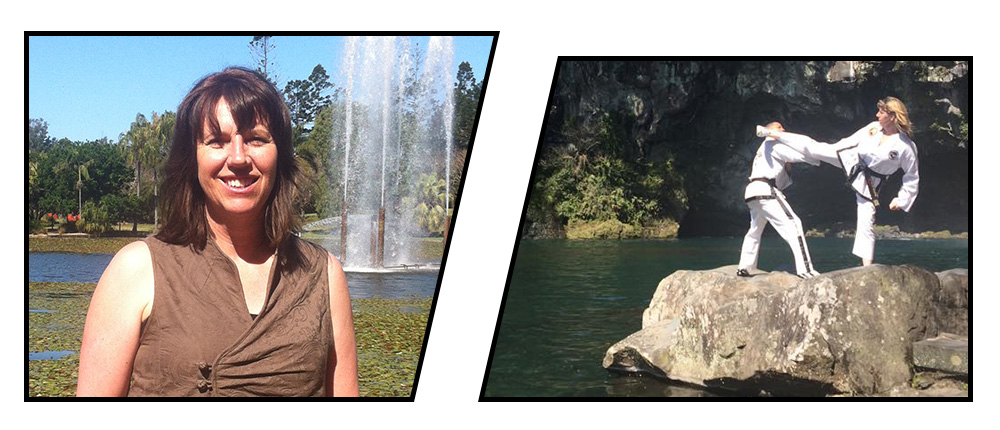MEET ALL OUR INTERNATIONAL WOMEN IN ENGINEERING DAY HEROES
An accomplished martial artist, electrical engineer Dr Catherine Galvin FIEAust CPEng knows better than most the toll physical activity can take on a body’s joints — particularly the knees. She’s using her engineering knowledge to help people stay active for longer.
Galvin began taking taekwondo lessons at the age of 13. In three years, the student had become the teacher and, by the time she began an electrical and electronics engineering degree at the University of Adelaide, Galvin was confident enough to volunteer as president of its Taekwondo Club.
She went on to work as an engineer at Mitsubishi, moving on to Telstra and then the CSIRO, but never gave up martial arts, eventually running her own taekwondo school.
“As I got older I became more interested in how to modify the training for changing bodies and bodies with injuries,” she told create.
“I decided to do a quick part-time sport science degree, which ended up being an honours degree, and then I was able to marry the two [engineering and sports science] with my PhD. That was exciting.”

Galvin’s PhD research focused on knee motion, in particular using medical imaging such as CT scans and fluoroscopies to measure changes in knee motion due to disease.
Now a lecturer and researcher at the Australian National University (ANU), Galvin is looking beyond the disease to understand healthy knee motion and how to measure it. Along with some of her honours students, she has proposed a new, more accurate method of measuring knee motion, including analysing a moving 3D image of a joint.
“The knee joint is so important to human mobility and quality of life. If we can understand knee motion, we can then understand how disease changes motion, and find different ways of managing this,” she said.
“It’s a wonderful collaborative investigation involving orthopaedic surgeons, physiotherapists, biomechanists and electrical engineers, because we’re looking at using medical imaging to reproduce knee motion in three dimensions.
“That’s a huge breakthrough we’ve had over the last couple of years — we’re actually looking at the bones in a living person, as they’re moving.”
Galvin is also interested in using machine learning to develop a predictive model of knee osteoarthritis, pursuing this work with the Trauma and Orthopaedic Research Unit at Canberra Hospital. She said being able to solve real world problems and help improve the length of healthy, active life people can live is “a wonderful way to be a researcher”.
Another current field of research is the alignment of total knee replacements.
“Most orthopaedic surgeons have a particular method of aligning knees. With machine learning and modelling software, we are developing a method that will simulate thousands of different knee replacements and see what changes depending on the alignment of replacement,” she said.
“[Members of the medical team] ask questions and we try to answer them. It’s not just about developing something really fancy and then thinking about who will be able to use it. We’re solving the problems of people who are at the coalface … I never expected to be involved in medical research, but I absolutely love it.”
A practical profession
Becoming an engineer was “almost predestined” for Galvin, who was inspired by her mathematician mother and her father, who worked as an engineer at the Weapons Research Establishment in South Australia.
“It was exciting — my father would fly in a DC3 out to Woomera in outback SA and launch rockets,” she said.
“I have some amazing photos of him at the base of the rockets on the launching pad. It was a very exciting time in Australia and we were among the world’s leaders in upper atmospheric research. I love science, but I wanted to do something practical, and what my dad was doing was practical, applied science.”
She is eager to pass on her love of the profession to the next generation of engineers who sit in her electronics lectures at ANU.
“I’m very passionate about the education of future engineers, and the quality of the education. I’m training people to solve problems that we’re facing now and in the future … It’s all about an engineering mindset, a way of thinking, systematic approaches to problem solving.”
As for her own teachers, Galvin pointed to renowned electronics engineer Professor Kamran Eshraghian from the University of Adelaide as “an incredible mentor”.
“Over the last few years I’ve worked with other brilliant engineers, including Professor Mark Pickering from the University of New South Wales and Dr Nic Malagutti here at the ANU,” she said. “Plus I’m very excited by Dr Jeremy Smith’s development of our ANU Humanitarian Engineering Program.”
Looking to the future, Galvin would like to see a greater percentage of women in the seats of her lectures.
“We should aim for a more inclusive workforce. We have more girls now, but it’s nothing like a 50/50 split. Girls seem to be really interested in humanitarian engineering, biomedical engineering — solving real world problems. Those areas seem to attract women, which is great.”
